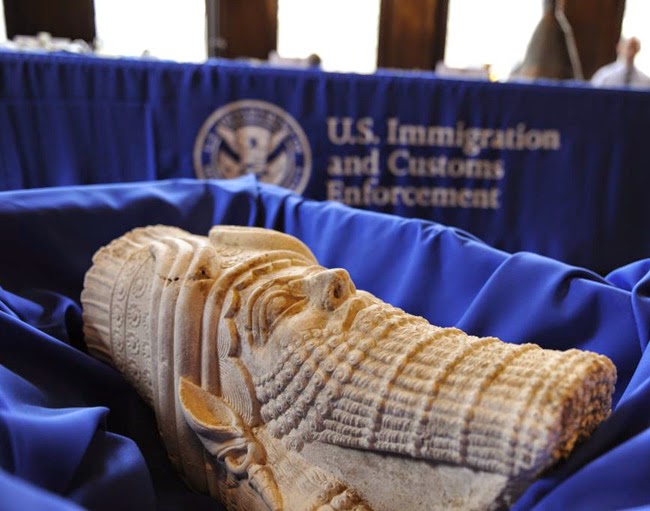The Assyrian Head Repatriation: Filling in the Details of ICE’s Investigation
ICE offered limited details in a press release about the artifact’s history. But the agency revealed that, “[a]s part of ‘Operation Lost Treasure,’ HSI New York special agents received information on June 30, 2008, that an antiquities dealer based in Dubai was selling looted Iraqi antiquities to dealers around the world. The special agents seized the limestone statue on Aug. 13, 2008, after it was shipped to New York by a Dubai-based antiquities trading company owned by the antiques dealer.”
 |
| Assyrian limestone head fragment of Sargon II repatriated by the U.S. to Iraq on Monday. Courtesy ICE |
The press statement added that the “investigation identified a broad transnational criminal organization dealing in illicit cultural property. Some of the network’s shipments were directly linked to major museums, galleries and art houses in New York.”
ICE reported that its investigation “resulted in one arrest, multiple seizures of antiquities ranging from Libya, Egypt, and Afghanistan, and the return of many of artifacts. A repatriation ceremony with Afghanistan was held two years ago and future repatriations are anticipated.”
Publicly available information fills in some of the details about the trafficked head fragment.
A CHL blog post dated July 24, 2013 reported that federal prosecutors petitioned to forfeit the Assyrian head in federal court in the Southern District of New York. The complaint, filed in the case of United States v. One Iraqi Assyrian Head, alleged that Dubai antiquities dealer Hassan Fazeli exported the artifact from the United Arab Emirates to the U.S. on July 30, 2008. Prosecutors, at the time, did not identify the head as a carving of Sargon II.
Prosecutors explained that Turkey was listed as the country of origin on the customs import form rather than Iraq. And the import form incorrectly listed the value as $6500 rather than $1.2 million, , according to the court complaint.
Prosecutors sent notice of the forfeiture to Hassan Fazeli Trading Company in Dubai, the potential civil claimant. But after time passed without a reply, on June 17, 2014 the federal district court entered a default judgment, awarding the Assyrian sculpture to U.S. authorities with instructions that the head must be repatriated within 90 days “or as soon thereafter as conditions in Iraq permit.”
The court granted an extension for the repatriation after a request made by an assistant prosecutor, who told the court that more than 90 days would be needed to return the artifact “[i]n light of [the] current state of world affairs.”
The judge asked why there had been a gap between the 2008 seizure of the artifact and the 2014 forfeiture. The assistant prosecutor responded:
I am not aware of why there was. I can offer that in many cases, your Honor, where there are assets to be forfeited, sometimes there are parallel investigations, criminal matters, and sometimes the government proceeds to file criminal charges in matters and items are forfeited in connection with criminal matters. Sometimes the government decides to just proceed civilly. This is a civil complaint in which the forfeiture is purely in rem and only the item that is at issue is being forfeited.
Mr. Fazeli … was attempting to sell this stolen item or an item that we believe to be removed from Iraq in violation of Iraqi law and in contravention of United States regulations as well. This individual, Fazeli, tried to sell it to the CS [confidential source] and based on recorded conversations, based on an investigation by Homeland Security, eventually was able to ship it to the United States with false documentation indicating false origin, actually indicated that the item was from Turkey.
Alshdaifat pleaded guilty in December 2012 to a misdemeanor charge of accessory after the fact in the case of U.S. v. Khouli et al and received a sentence of a $1000 fine.
At that ceremony, federal authorities returned an ancient Roman oinochoe, three 5th century B.C. gold foil appliques, and two 17th century gold ornaments from approximately the 17th century. ICE explained in an accompanying press release:
On March 21, 2011, U.S. Customs and Border Protection and the HSI New York El Dorado Task Force seized a shipment containing the gold artifacts and the ancient vase at Newark Liberty International Airport, Central Air Cargo Examination Facility, after HSI New York special agents discovered they were destined for a New York City man and later to a New York business suspected of dealing in looted cultural property. Through the investigative process, the antiquities were found to have originated in Afghanistan. On Jan. 25, 2012, the shipment was administratively forfeited.
Hopefully the federal agency will provide more complete details describing the investigation, recovery, and return of the Assyrian head fragment now that the matter has been concluded by ICE.

